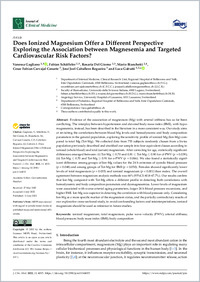Does ionized magnesium offer a different perspective exploring the association between magnesemia and targeted cardiovascular risk factors?
- Gagliano, Vanessa Department of Internal Medicine, Clinical Research Unit, Regional Hospital of Bellinzona and Valli, Ente Ospedaliero Cantonale, Bellinzona, Switzerland
- Schäffeler, Fabian Faculty of Biomedical Sciences, Università della Svizzera italiana, Switzerland
- Del Giorno, Rosaria ORCID Faculty of Biomedical Sciences, Università della Svizzera italiana, Switzerland - Angiology Service, University Hospital of Lausanne, Switzerland
- Bianchetti, Mario ORCID Faculty of Biomedical Sciences, Università della Svizzera italiana, Switzerland - Department of Pediatrics, Regional Hospital of Bellinzona and Valli, Ente Ospedaliero Cantonale, Bellinzona, Switzerland
- Carvajal Canarte, Cesar Fabian Department of Internal Medicine, Clinical Research Unit, Regional Hospital of Bellinzona and Valli, Ente Ospedaliero Cantonale, Bellinzona, Switzerland
- Caballero Regueira, José Joel Department of Internal Medicine, Clinical Research Unit, Regional Hospital of Bellinzona and Valli, Ente Ospedaliero Cantonale, Bellinzona, Switzerland
- Gabutti, Luca ORCID Department of Internal Medicine, Clinical Research Unit, Regional Hospital of Bellinzona and Valli, Ente Ospedaliero Cantonale, Bellinzona, Switzerland - Faculty of Biomedical Sciences, Università della Svizzera italiana, Switzerland
- 2022
Published in:
- Journal of Clinical Medicine. - 2022, vol. 11, no. 14, p. 4015
Ionized magnesium
Total magnesium
Pulse wave velocity (PWV)
Arterial stiffness
Blood pressure
Body mass index (BMI)
Body composition
English
Evidence of the association of magnesium (Mg) with arterial stiffness has so far been conflicting. The interplay between hypertension and elevated body mass index (BMI), with hypomagnesemia, instead, has been described in the literature in a more consistent way. Our study aims at revisiting the correlations between blood Mg levels and hemodynamic and body composition parameters in the general population, exploring the sensitivity profile of ionized Mg (Ion-Mg) compared to total Mg (Tot-Mg). We collected data from 755 subjects randomly chosen from a Swiss population previously described and stratified our sample into four equivalent classes according to ionized (whole blood) and total (serum) magnesium. After correcting for age, statistically significant differences emerged between: (i) Tot-Mg ≤ 0.70 and 0.81 ≤ Tot-Mg ≤ 0.90 for cf-PWV (p = 0.039); (ii) Tot-Mg ≤ 0.70 and Tot-Mg ≥ 0.91 for o-PWV (p = 0.046). We also found a statistically significant difference among groups of Ion-Mg values for the 24 h extremes of systolic blood pressure (p = 0.048) and among groups of Tot-Mg for BMI (p = 0.050). Females showed significantly lower levels of total magnesium (p = 0.035) and ionized magnesium (p < 0.001) than males. The overall agreement between magnesium analysis methods was 64% (95%CI: 60.8–67.7%). Our results confirm that Ion-Mg compared with Tot-Mg offers a different profile in detecting both correlations with hemodynamic and body composition parameters and dysmagnesemias. Lower levels of magnesium were associated with worse arterial aging parameters, larger 24 h blood pressure excursions, and higher BMI. Ion-Mg was superior in detecting the correlation with blood pressure only. Considering Ion-Mg as a more specific marker of the magnesium status, and the partially contradictory results of our explorative cross-sectional study, to avoid confounding factors and misinterpretations, ionized magnesium should be used as reference in future studies.
- Collections
- Language
-
- English
- Classification
- Medicine
- License
- Open access status
- gold
- Identifiers
-
- DOI 10.3390/jcm11144015
- ARK ark:/12658/srd1331860
- Persistent URL
- https://n2t.net/ark:/12658/srd1331860
Statistics
Document views: 55
File downloads:
- Gabutti_2022_MDPI_jcm_Does Ionized Magnesium Offer: 47
